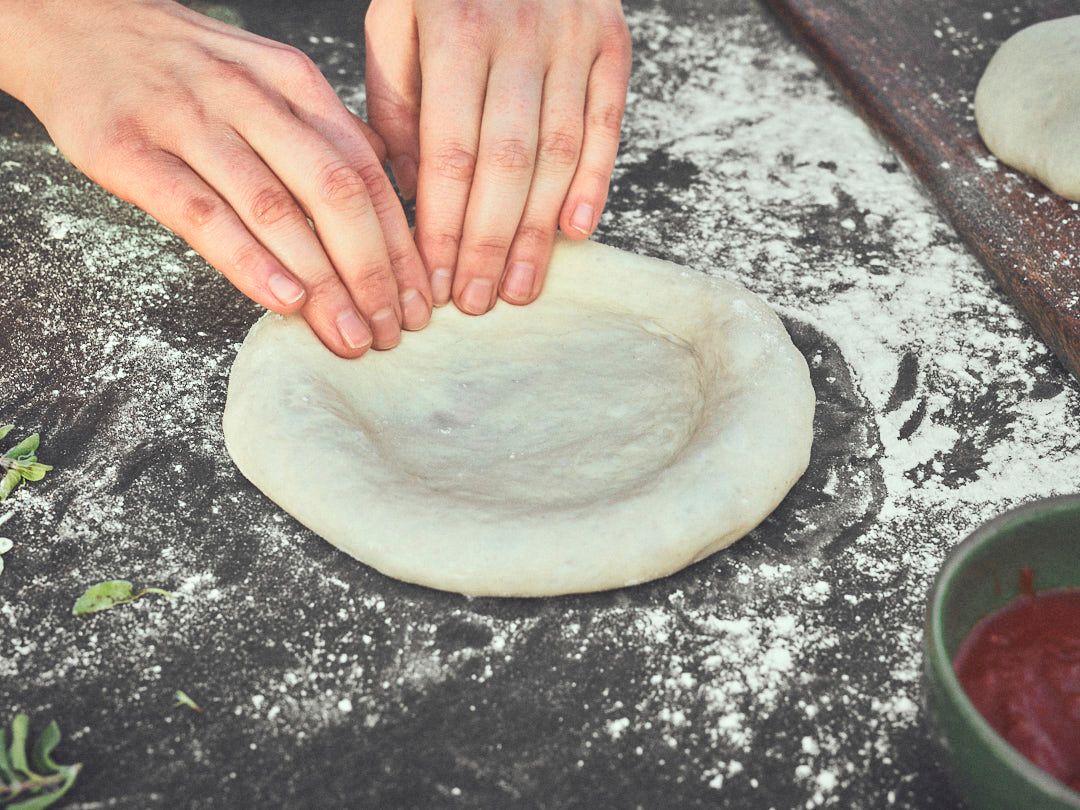
Our beloved pizza originates from Naples and was considered street food for poor people in the 18th and 19th centuries. Simple, flat bread topped with various toppings, such as tomatoes. Today, we almost consider pizza to be a staple food and it is a regular item on the menu of both the poor student and the multi-millionaire, I would argue. And rightly so! After all, what could be better than biting into a hot, crispy, fluffy, fresh pizza? Once you've tasted authentic Italian pizza, you won't want to know anything more about frozen pizza.
The good news: really tasty pizza dough only needs a good recipe and a handful of ingredients. Flour, salt, yeast, water and a little olive oil are all you need.
But the most important ingredient is above all: time! A relaxed, slow rising time: 6 hours at room temperature is a solid start. It gets really authentic if you give your pizza dough 24 or even 48 hours. Fermentation not only brings even more flavor to your pizza dough, but also makes it more digestible. The yeast has enough time to dissolve more complex sugar compounds (so-called FODMAPs) that might otherwise cause problems for your stomach. Incidentally, this is also the reason why sugar has no place in pizza dough.
MY TIP:
But your pizza set-up at home is at least as important as the perfect dough:
Dough preparation: A handy dough spatula helps with portioning and handling. For the rising time, it is best to pack your dough into sealable pizza boxes with lids during the stick and piece proofing.
Baking process: The best way to transfer the topped pizza blanks and the baked pizza is with a large pizza peel. No matter where your pizza ends up, you can bake good pizzas both in the oven and on the gas grill with a suitable pizza stone. Of course, pizzas can only be baked as well and in the authentic Neapolitan style as at the Italian restaurant in a pizza oven, as only this can reach the required temperatures.
Here is a brief overview of the 3 baking methods:
1. In the pizza oven - the optimum:
Regardless of whether you use wood, pellets or gas - let the oven preheat properly, make sure that the flames flicker along the ceiling (keyword: top heat!) and that it reaches 500 °C. You can find out the best way to do this in our guide to firing up the pizza oven! Also important: keep the toppings to a minimum. Why? The thicker the pizza, the longer it takes to cook in the middle and the quicker the crust will burn. Speaking of the crust: During baking, you should turn the hot slice in the oven at least once so that it cooks evenly. This works best with a handy pizza turner!
2. In the gas grill with pizza stone - the alternative outdoor method
If your gas barbecue is big enough (it works perfectly with EARL or Big FRED!), you can also use a pizza stone to bake delicious pizzas. Of course, heat the cordierite stone properly before baking. To get as close as possible to the circulating air effect and top heat of a real pizza oven, there's a simple trick: use a brick, an upturned oven dish or something similar to ensure that your pizza stone is raised in the grill instead of placing it directly on the grates. This will allow the hot air under the lid to circulate directly along your pizza and give it a great, crispy finish!
3. In the oven - the indoor method
Even if the oven at home probably can't scratch the 500 °C mark - you can still bake solid pizzas with a crispy base and fluffy crust with a pizza stone!
Simply place the pizza stone as high up in the oven as possible and preheat for at least 30-40 minutes at maximum heat (top/bottom heat). Finally, activate the grill function (it gives the stone a final heat boost before the dough is placed on it) and prepare the pizza. Set the oven back to top/bottom heat and bake the pizza for 6-8 minutes. If necessary, use the grill function again at the end to give the pizza a crispy finish. But be careful: it's best to stand by the oven and make sure you don't burn your dream pizza at the end!
Ingredients
For 4 servings
Equipment
nutritional values per serving
Preparation in 10 steps
Dissolve salt completely in cold water by stirring in a large bowl.
Add 2 handfuls of flour to the bowl and mix thoroughly with your hands.
Crumble yeast over the water and stir until completely dissolved.
Add the remaining flour gradually to the bowl, roughly mix with your hands for about 3 minutes, and let it stand for 10 minutes.
Place the dough on a lightly floured work surface and knead for about 20 minutes until smooth (about 10 minutes in a stand mixer). The dough should be elastic and not tear. The core temperature of the dough should now be 23–26 °C.
Grease the bottom and walls of a bowl or dough box with 1 tbsp of olive oil. Shape the dough into a ball, place it in the bowl/box, and rub with 1 tbsp of olive oil to prevent it from drying out.
Let it rise covered at room temperature for 2-3 hours.
Cut dough into 4 equal parts and shape into balls. Brush the base of a baking sheet or a dough box with the remaining oil and place the dough balls on it with some space in between. Wrap the baking sheet with plastic wrap or close the dough box with a lid and let the dough balls rise again for 6 hours at room temperature. Alternatively, let them rise in the refrigerator for 24 to 48 hours and take them out 3 hours before processing.
Shape dough balls into a round pizza on a lightly floured work surface by pressing and stretching with hands from the center outwards. Leave a 3 cm border.
Then top the pizza dough as desired and bake - see "TIP".
